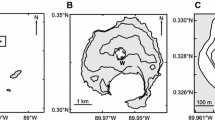Abstract
Devil Lake is morphologically complex as a result of Pleistocene glacial erosion of the Frontenac Axis of the Canadian Shield. In order to assess the processes causing highly variable sedimentation in the lake, we monitored currents, suspended sediment and temperature in the lake before and during autumn overturn in 2002. Strong summer thermal stratification (stability number to 0.11 s−1 declining with the approach of overturn) was insufficient to prevent a dynamic response in the hypolimnion to wind forcing. Superimposed on a gradual increase in suspended sediment concentration in the last weeks of stratification from less than 2 μg/l to about 30 μg/l were shorter-term rises lasting up to several days. Associated with these events was an increase in particle size of the sediment from a mode of 40–50 to 150–200 μm ascribed to flocculation from primary particles. These events culminated in rapid (<1 h) clearing of the water associated with strong, sustained winds over the lake, especially from the southwest. After overturn, the events were more frequent, and flocculation was unable to develop as well in the more vigorous circulation. However, currents in the hypolimnion occurred throughout the period before, during and after overturn with speed related to wind speed, but direction largely independent of wind direction. The results represent an approach to understanding the nature of sedimentary processes and thus to strengthening the use of sedimentary records as proxy in environmental and paleoenvironmental assessment.
Similar content being viewed by others
References
Agbeti M.D., Kingston J.C., Smol J.P. and Watters C. 1997. Comparison of phytoplankton succession in two lakes of different mixing regimes. Arch. Hydrobiol. 140: 37–69.
AES (Atmospheric Environment Service), 1984. Principal Station Data Kingston A. Environment Canada PSD-38.
CERC (Coastal Engineering Research Center), 1973. Shore Protection Manual. U.S. Army Corps of Engineers, Washington, 3 volumes.
Droppo I.G., Leppard G.G., Flanningan D.T. and Liss S.N. 1997. The freshwater floc: a functional relationship of water and organic and inorganic floc constituents affecting suspended sediment properties. Water Air Soil Pollut. 99: 43–54.
Eisma D. 1991. Particle size of suspended matter in estuaries. Geomar. Lett. 11: 147–153.
Gilbert R. 1999. Calculated wave base in relation to the observed patterns of sediment deposition in northeastern Lake Ontario. J. Great Lakes Res. 25: 883–891.
Gilbert R. 2003. Spatially irregular sedimentation in a small, morphologically complex lake: implications for paleoenvironmental studies. J. Paleolim. 29: 209–220.
Håkanson L. and Jansson M. 1983. Principles of Lake Sedimentology. Springer, Berlin, 316 pp.
Hjulstrom F. 1935. Studies of the morphological activity of rivers as illustrated by the River Fyris. Univ. Upsala Geol. Inst. Bull. 25: 221–527.
Hutchinson G.E. 1957. A Treatise on Limnology. Vol. 1: Geography, Physics, and Chemistry. Wiley, New York, 1015 pp.
Imboden D.M. and Wüest A. 1995. Mixing mechanisms in lakes. In: Lerman A., Imboden D. and Gat J. (eds), Physics and Chemistry of Lakes, Springer, Berlin, pp. 83–138.
Johnson T.C. 1980. Sediment redistribution by waves in lakes, reservoirs and embayments. In: Proceedings of the Symposium on Surface Water Impoundments American Society of Civil Engineers, pp. 1307–1317.
Kingston P.W., Papertzian V.C. and Williams D.A. 1985. Geology and Mineral Deposits of the Kingston Area, Southern Ontario. Ontario Geological Survey Map P. 2611. Scale 1: 50 000.
Lerman A., Imboden D. and Gat J. (eds.) 1995. Physics and Chemistry of Lakes. Springer, Berlin, 334 pp.
Norrman J.O. 1964. Lake Vattern investigations on shore and bottom morphology. Geogr. Ann. XLVI Ser. A: 1–238.
Ottesen-Hansen N.-E. 1978. Effects of boundary layers on mixing in small lakes. In: Mortimer C.H. (ed.), Hydrodynamics of Lakes, Elsevier, Amsterdam, pp. 341–356.
Saarinen T. and Petterson G. 2001. Image analysis techniques. In: Last W.M. and Smol J.P. (eds), Tracking Environmental Change Using Lake Sediments. Vol. 2. Physical and Geochemical Methods, Kluwer Academic Publishers, Dordrecht, pp. 23–40.
Sinclair I.R. and Smith I.J. 1972. Deep water waves in lakes. Freshwater Biol. 2: 387–399.
Author information
Authors and Affiliations
Rights and permissions
About this article
Cite this article
Gilbert, R., Lamoureux, S. Processes affecting deposition of sediment in a small, morphologically complex lake. Journal of Paleolimnology 31, 37–48 (2004). https://doi.org/10.1023/B:JOPL.0000013279.78388.24
Issue Date:
DOI: https://doi.org/10.1023/B:JOPL.0000013279.78388.24




